With nearly 100 launches and unveils, the Bharat Mobility Global Expo 2025, held in Delhi from January 17 to 22, made one thing clear to automobile enthusiasts: Electric vehicles (EVs) are the way ahead for the Indian auto market for years to come.

There were dazzling cars, sleek bikes, and imposing commercial vehicles on twirling platforms by as many as 34 companies.
Add to that 1,100 domestic and international auto component giants. With nearly 100 launches and unveils, the Bharat Mobility Global Expo 2025, held in Delhi from January 17 to 22, made one thing clear to automobile enthusiasts: Electric vehicles (EVs) are the way ahead for the Indian auto market for years to come.
Not just that, several companies that lined up their electric products also vowed to expand their wings in building an EV ecosystem.
From Maruti Suzuki e-Vitara to Tata's Avinya to Hyundai's Creta Electric to Tesla's Vietnamese rival VinFast's first two products in India, e-mobility and decarbonisation were the highlights of the event with as many as 26 EVs launched in the first four days.
The hype around alternative energy further increased when Prime Minister Narendra Modi said the country's EV sales might grow eight-fold by the end of this decade, giving impetus to the dreams of vehicle manufacturers, component makers, and consumers.

“As far as the automobile industry in India is concerned, this event served as an excellent platform to showcase our commitment to sustainable mobility and decarbonisation, highlighted by the display of EVs, flex-fuel options, and other alternative powertrains.
"We also witnessed the largest ever participation from vehicle manufacturers across segments. This includes prominent pure EV players such as Ola Electric, Eka Mobility, Ather Energy, and VinFast.
"Additionally, the event saw an impressive footfall,” said Rajesh Menon, director general of the Society of Indian Automobile Manufacturers.
SIAM is one of the partner organisations for the industry-led expo, which is supported by the government.
During the inaugural ceremony, Commerce and Industry Minister Piyush Goyal said the event was going to be the second largest auto show in the world in 2025.
By January 22, this turned out to be correct -- the show attracted more than 950,000 people.
That puts it in the top echelons of global auto shows, such as the “Big Five” in Frankfurt, Geneva, Detroit, Paris, and Tokyo, and the newer ones in Shanghai and Munich.

Bharat Mobility was spread over three locations: The vehicle show was at the Bharat Mandapam in the heart of New Delhi, the component show at Yashobhoomi (India International Convention and Expo Centre), and the construction equipment show, urban mobility, and infrastructure displays at the India Expo Centre and Mart in Greater Noida.
It came at a time when there are concerns that the annual motor show in Geneva, which started more than a century ago, could be shelve due to dwindling interest and difficult market conditions.
In India, too, industry majors like Honda Cars, Renault, and Nissan, among others, stayed away this year.
The government, for its part, took the opportunity to bring in diplomacy, allowing Chinese executives from various companies to be part of the event after several years.

Major attractions
Maruti's first EV, the e-Vitara, a premium SUV with a range of more than 500 km, was the most anticipated launch.
India's largest carmaker plans to ready 1,500 EV-enabled service workshops across 1,000 cities and set up fast chargers every five to 10 km in the top 100 cities which constitute 97 per cent of the EV market.
To address range concerns that still remain, Maruti will introduce a leasing scheme allowing EV owners to temporarily use its petrol or hybrid cars for long trips.
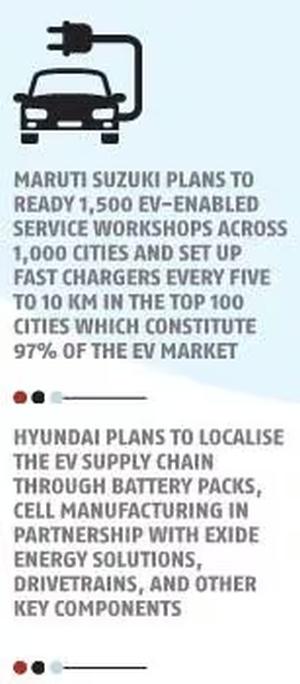
The company aims to encourage EV adoption through a dedicated app, “e for me”, and support installation of home chargers.
The company wants to become the largest electric car maker in the country within a year.
Hyundai, the second largest carmaker in India after Maruti, which unveiled the Creta Electric SUV -- its first car after its stock market debut -- is similarly keen on building an ecosystem.
It plans to localise the EV supply chain through battery packs, cell manufacturing in partnership with Exide Energy Solutions, drivetrains, and other key components, alongside expanding the charging infrastructure.
Another example of a global major trying to have a 360-degree presence in India's EV segment is VinFast.
The Vietnamese company, which is coming up with a $2 billion facility in Tamil Nadu's Thoothukudi, will focus on battery manufacturing and setting up of charging stations across the country through its sister company, V-Green.
Chinese automaker BYD showcased the Sealion 7, a premium electric SUV expected to cost Rs 40-45 lakh, with deliveries starting in March.
BYD is focusing on the Rs 25-45 lakh segment while evaluating entry into more affordable price brackets.
The company currently imports all its vehicles from China, working to build trust in the Indian market through technology and products.
It is exploring customer interest in plug-in hybrids, such as the Sealion 6, but has no immediate plans for joint ventures or local manufacturing. BYD aims at double-digit growth in 2025.
When asked if being a Chinese company was holding it back in India, BYD's Head of Electric Passenger Vehicles in the country, Rajeev Chauhan, said: “It has been said in the media, but it has to be a win-win situation for everyone. It has to be a good business case.
"We are definitely open (to investments)... we are going step by step. We want the customers to first experience our technology. We are still in that phase of building trust and confidence.”

Tata Motors, which presented the Avinya, displayed 14 smart vehicles in its commercial vehicle segment, all integrated with Advanced Driver Assistance Systems, across powertrain options: Diesel, biodiesel, compressed natural gas, liquefied natural gas, ethanol, battery electric, and hydrogen internal combustion engine.
Similarly, almost all commercial vehicle players showcased their strength in EVs and other alternative energy segments.

On the component side, too, this was the largest ever show in India. “We had about 1,100 exhibitors, spread over 70,000 square meters of space, and had over 90 product launches. The venues were world-class, with all amenities that international shows have. We had over 100,000 visitors, which is also unheard of for a B2B (business-to-business) show,” said Vinnie Mehta, Director General of the Automotive Component Manufacturers Association, another partner organisation for the expo. The industry expects double digit growth until 2030.
The newfound enthusiasm was visible in the components sector when the industry body thanked Modi through an advertisement in Thursday's newspapers for the auto show with the tagline: “Make In India For The World.”
Those who followed this year's Bharat Mobility might like to add: With the decarbonisation agenda on top.
Feature Presentation: Rajesh Alva/Rediff.com

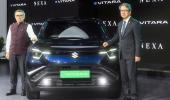

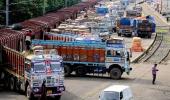
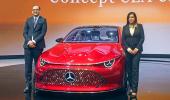
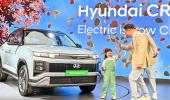



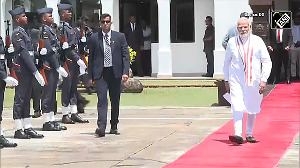
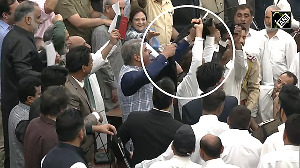
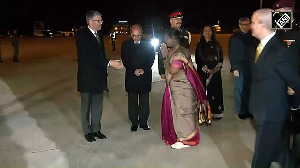
 © 2025
© 2025